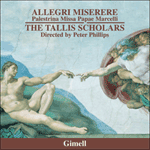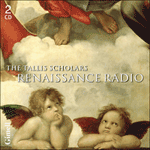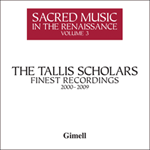
Welcome to Hyperion Records, an independent British classical label devoted to presenting high-quality recordings of music of all styles and from all periods from the twelfth century to the twenty-first.
Hyperion offers both CDs, and downloads in a number of formats. The site is also available in several languages.
Please use the dropdown buttons to set your preferred options, or use the checkbox to accept the defaults.

| The Tallis Scholars, Peter Phillips (conductor), Deborah Roberts (soprano), Sally Dunkley (soprano), Caroline Trevor (alto), Donald Greig (baritone), Andrew Carwood (tenor)» More |
However, just as the Pope had feared, once the Miserere was heard outside the magical confines of the Sistine Chapel, the music was found to lose its power to astonish. The problem with any performance of it, then as now, is that what Gregorio Allegri himself composed is simple and plain. Everything depends on the embellishments which are added to Allegri’s chords. There was a tradition of improvising amongst the Papal singers which no other group of singers could match, so in a way the fact that copies of the music escaped the confines of the Vatican didn’t make much difference to the fame or development of the piece: one still had to go to the Sistine Chapel to hear it sung to its fullest potential. It seems likely that the embellishments got more and more effective as the decades passed until by the end of the nineteenth century the best of them had also been written down and become part of the composition. By then they included the high C which has so characterized the piece in recent times. For modern performers there remains the option of adding extra embellishments to the ‘established embellishments’, which is what Deborah Roberts has done here. These are the fruit of her experiments across most of the 300 performances that The Tallis Scholars have given. She and I acknowledge the irony of writing down these improvisations, but if making them available in print means that yet more dazzling roulades will be invented by subsequent performers then we are probably only doing what the Papal singers did when they listened to each other centuries ago.
from notes by Peter Phillips © 2007
Toutefois, comme l’avait craint le pape, le Miserere perdit sa capacité à surprendre dès lors qu’on put l’entendre hors du cadre magique de la chapelle Sixtine. Le problème quand on l’interprète, hier comme aujourd’hui, c’est que Gregorio Allegri composa une musique simple, quelconque: tout dépend des ornements que l’on ajoute aux accords. Les chanteurs papaux avaient une tradition d’improvisation qu’aucun autre ensemble vocal ne pouvait égaler et, d’une certaine manière, le fait que des copies aient circulé en dehors du Vatican ne changea guère la renommée ou l’évolution de l’œuvre: il fallait toujours aller à la chapelle Sixtine pour l’entendre chantée dans la plénitude de son potentiel. Les ornements furent, probablement, de plus en plus réussis au fil des décennies et les meilleurs d’entre eux, écrits en toutes notes à la fin du XIXe siècle, en vinrent à faire partie intégrante de la composition. Tel fut le cas du contre-ut devenu, ces derniers temps, si emblématique de l’œuvre. Reste pour les interprètes actuels la possibilité d’ajouter des ornements aux «ornements établis», ce que Deborah Roberts a fait ici. Tout comme elle, je reconnais l’ironie qu’il y a à consigner ces improvisations, mais si le fait de les rendre disponibles signifie qu’encore plus d’éblouissantes roulades seront inventées par les interprètes de demain, alors nous ne faisons probablement que suivre les traces des chanteurs papaux quand ils s’écoutaient voilà des siècles.
extrait des notes rédigées par Peter Phillips © 2007
Français: Gimell
Doch wie der Papst befürchtet hatte verlor das Miserere seine Kraft, zu erstaunen, nachdem es außerhalb der magischen Grenzen der Sixtinischen Kapelle zu hören war. Das Problem mit seiner Aufführung – damals wie heute – ist, dass Gregorio Allegris eigene Komposition einfach und schlicht ist. Alles beruht auf den Ornamenten, mit denen Allegris Akkorde ausgeziert werden. Unter den päpstlichen Sängern existierte eine Tradition der Improvisation, denen kein anderes Ensemble von Sängern gleichkam, und daher machte die Tatsache, dass Kopien der Musik den Vatikan verließen, kaum einen Unterschied für den Ruhm oder die Entwicklung des Stückes machten: man musste immer noch in die Sixtinische Kapelle gehen, um es zu seinem vollen Potential gesungen zu hören. Wahrscheinlich wurden die Verzierungen im Lauf der Jahrzehnte immer wirkungsvoller bis zum Ende des Jahrhunderts die besten unter ihnen auch aufgezeichnet und Teil der Komposition wurden. Schon damals gehörte das hohe C dazu, das in jüngerer Zeit so charakteristisch für das Stück wurde. Für moderne Interpreten bleibt noch die Möglichkeit, den „etablierten Verzierungen“ weitere hinzuzufügen, was Deborah Roberts in dieser Aufnahme tat. Sie sind das Resultat ihrer Experimente in den meisten der 300 Aufführungen, die die Tallis Scholars sangen. Wir sind uns beide der Ironie bewusst, solche Improvisationen niederzuschreiben, aber wenn ihre Veröffentlichung im Druck bedeutet, dass zukünftige Interpreten mehr glänzende Rouladen erfinden, tuen wir wohl nur, was die päpstlichen Sänger Jahrhunderte zuvor taten, wenn sie einander zuhörten.
aus dem Begleittext von Peter Phillips © 2007
Deutsch: Renate Wendel
 Allegri: Miserere; Palestrina: Missa Papae Marcelli Allegri: Miserere; Palestrina: Missa Papae MarcelliMusic written for the Sistine Chapel, including two new recordings of Allegri's Miserere—one with the familiar top Cs, and one with additional embellishments developed by Deborah Roberts during hundreds of concert performances by The Tallis Schola ...» More |
 Renaissance Radio Renaissance RadioSacred Music from the Renaissance Era for Celestial and Secular Radio. When Peter Phillips founded The Tallis Scholars in 1973 sacred vocal music from the Renaissance Era was seldom heard on radio. Now it is firmly established as one of the great ...» More |
 Sacred Music in the Renaissance, Vol. 3 Sacred Music in the Renaissance, Vol. 3The third of three volumes featuring The Tallis Scholars' finest recordings, one for each decade, and each offering over five hours of the award-winning performances that helped establish Renaissance Polyphony as one of the great repertoires of we ...» More |

